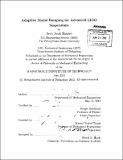| dc.contributor.advisor | Nergis Mavalvala and Kamal Youcef-Toumi. | en_US |
| dc.contributor.author | Shapiro, Brett N. (Brett Noah) | en_US |
| dc.contributor.other | Massachusetts Institute of Technology. Dept. of Mechanical Engineering. | en_US |
| dc.date.accessioned | 2012-11-19T19:19:40Z | |
| dc.date.available | 2012-11-19T19:19:40Z | |
| dc.date.copyright | 2012 | en_US |
| dc.date.issued | 2012 | en_US |
| dc.identifier.uri | http://hdl.handle.net/1721.1/74933 | |
| dc.description | Thesis (Ph. D.)--Massachusetts Institute of Technology, Dept. of Mechanical Engineering, 2012. | en_US |
| dc.description | Cataloged from PDF version of thesis. | en_US |
| dc.description | Includes bibliographical references (p. 179-183). | en_US |
| dc.description.abstract | Gravitational waves are predicted to exist by Einstein's Theory of General Relativity. The waves interact extremely weakly with the surrounding universe so only the most massive and violent events such as supernovae and collisions of black holes or neutron stars produce waves of sufficient amplitude to consider detecting. The Laser Interferometer Gravitational-Wave Observatory (LIGO) aims to pick up the signals from these very faint waves. LIGO directs much of its effort to the areas of disturbance rejection and noise suppression to measure these waves. The work in this thesis develops an adaptive modal damping control scheme for the suspended optics steering the laser beams in the LIGO interferometers. The controller must damp high quality factor mechanical resonances while meeting strict noise and disturbance rejection requirements with the challenges of time varying ground vibrations, many coupled degrees of freedom, process noise, and nonlinear behavior. A modal damping scheme is developed to decouple the complex system into many simpler systems that are easily controlled. An adaptive algorithm is then built around the modal damping scheme to automatically tune the amount of damping applied to each mode to achieve the optimal trade-off between disturbance rejection and noise filtering for all time as the non-stationary stochastic disturbances evolve. The adaptation is tuned to provide optimal sensitivity to astrophysical sources of gravitational waves. The degree of sensitivity improvement is analyzed for several classes of these sources. | en_US |
| dc.description.statementofresponsibility | by Brett Noah Shapiro. | en_US |
| dc.format.extent | 183 p. | en_US |
| dc.language.iso | eng | en_US |
| dc.publisher | Massachusetts Institute of Technology | en_US |
| dc.rights | M.I.T. theses are protected by
copyright. They may be viewed from this source for any purpose, but
reproduction or distribution in any format is prohibited without written
permission. See provided URL for inquiries about permission. | en_US |
| dc.rights.uri | http://dspace.mit.edu/handle/1721.1/7582 | en_US |
| dc.subject | Mechanical Engineering. | en_US |
| dc.title | Adaptive modal damping for advanced LIGO suspensions | en_US |
| dc.type | Thesis | en_US |
| dc.description.degree | Ph.D. | en_US |
| dc.contributor.department | Massachusetts Institute of Technology. Department of Mechanical Engineering | |
| dc.identifier.oclc | 815957616 | en_US |
